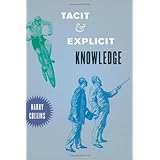
Average Reviews:

(More customer reviews)Are you looking to buy Tacit and Explicit Knowledge? Here is the right place to find the great deals. we can offer discounts of up to 90% on Tacit and Explicit Knowledge. Check out the link below:
>> Click Here to See Compare Prices and Get the Best Offers
Tacit and Explicit Knowledge ReviewAn interesting book that attempts to explain the differences between explicit and tacit knowledge in formal philosophical terms. The author is a social scientist and he draws on his studies of science so I suspect the text is not quite as formal as a philosopher might require. As a researcher interested in technical occupations I found it more interesting than I expected and well worth the modest price.His basic notion is that explicit knowledge is knowledge that can be represented as a string and passed through an intermediary (such as the Internet) without any loss of information. A string is a general term to represent characters, numbers, computer codes etc. The book is a fascinating exploration of the differences between human and artificial intelligence and links together many of the interesting experiments (both thought and actual) that have been published in the last 50 years.
He introduces some very interesting ideas. For example, the degree to which tacit knowledge is required to understand strings, even compose them in the first place.
He revisits Michael Polanyi's discussion on riding bicycles with the notion of somatic tacit knowledge, knowledge that becomes part of our body for the performance of mechanical tasks. He argues that this can be reduced to mechanical instructions, even though these instructions could not reasonably be performed by human in the required timescale. What attracted my attention was a footnote in which he dismisses actor network theory as "the so-called actor network theory has succeeded brilliantly in the academic market place by cleverly failing to acknowledge this obvious asymmetry and claiming that its absence from the theory represents a philosophical insight." I have not yet finished reading Latour's book so I will keep a lookout for this issue.
The asymmetry to which he refers is the notion that a blind man's stick becomes part of a blind man: the man uses the stick as an extension of his own self. However, we cannot say that the blind man has become part of the stick. (Page 114).
In the final chapter he talks about collective tacit knowledge and social Cartesianism, the notion that there is a distinct difference between humans and animals because, he argues, that humans are capable of reorganising their tacit knowledge to fit in with the social patterns of different social setting. Dogs, cats and other animals, he argues, cannot socialise at all. I think that this is the least impressive chapter in the book, in my opinion, because it seems out of touch with recent research, even common sense, that if humans cannot socialise effectively with animals since we cannot speak their language, it says nothing that animals cannot socialise effectively with humans. For example, there is plenty of evidence that whales have a complex social life and language. While I disagree with the detail of the chapter I'm happy with the conclusions that, for example, direct face-to-face human interaction is essential in order to acquire collective tacit knowledge. Where I differ is in his conclusion that teleconferencing will never be a substitute for air travel. Just as human beings are remarkably adaptable, teleconferencing has an enormous potential for improvement with genuine broadband transmission, and while it will never be quite the same as being there in person, has a long way to go in terms of development. I think eventually that he will be proved wrong in this conclusion.
Tacit and Explicit Knowledge OverviewMuch of what humans know we cannot say. And much of what we do we cannot describe. For example, how do we know how to ride a bike when we can't explain how we do it? Abilities like this were called "tacit knowledge" by physical chemist and philosopher Michael Polanyi, but here Harry Collins analyzes the term, and the behavior, in much greater detail, often departing from Polanyi's treatment. In Tacit and Explicit Knowledge, Collins develops a common conceptual language to bridge the concept's disparate domains by explaining explicit knowledge and classifying tacit knowledge. Collins then teases apart the three very different meanings, which, until now, all fell under the umbrella of Polanyi's term: relational tacit knowledge (things we could describe in principle if someone put effort into describing them), somatic tacit knowledge (things our bodies can do but we cannot describe how, like balancing on a bike), and collective tacit knowledge (knowledge we draw that is the property of society, such as the rules for language). Thus, bicycle riding consists of some somatic tacit knowledge and some collective tacit knowledge, such as the knowledge that allows us to navigate in traffic. The intermixing of the three kinds of tacit knowledge has led to confusion in the past; Collins's book will at last unravel the complexities of the idea. Tacit knowledge drives everything from language, science, education, and management to sport, bicycle riding, art, and our interaction with technology. In Collins's able hands, it also functions at last as a framework for understanding human behavior in a range of disciplines.
Want to learn more information about Tacit and Explicit Knowledge?
>> Click Here to See All Customer Reviews & Ratings Now
0 comments:
Post a Comment